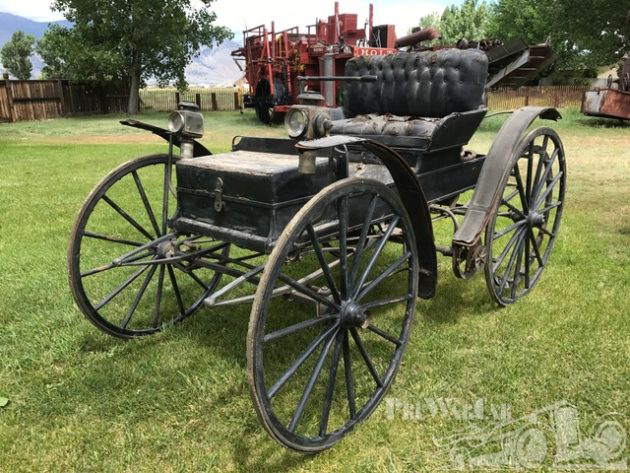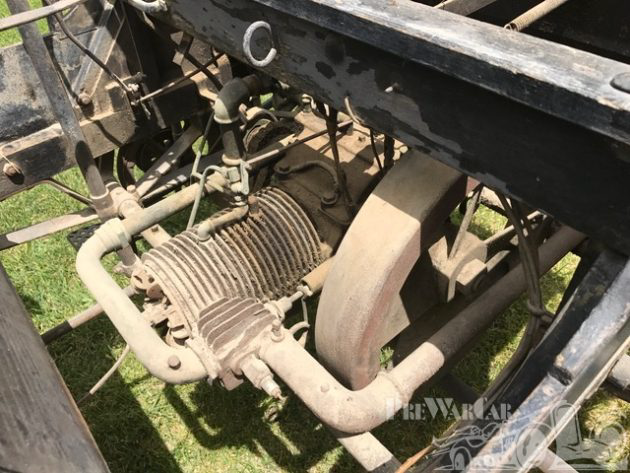Though much older than the cars I typically write about, I love Holsmans. This was a submission I couldn’t resist! McPherson College has a 1908 Holsman High Wheeler that is nearing completion that I have experience working around, but not working on. The Holsman High Wheeler is from a period of time that would steer the direction of the future of the automobile, and remains a relic of a time when cars weren’t quite cars yet. This example has spent 57 years in a museum and is now being offered for sale. Find it here on prewarcar.com with an asking price of $26,900. Many thanks to Dominic O. for sending this one in!
The engine is an air-cooled two-cylinder opposed design producing approximately 10 horsepower, depending where you get your information from. For those unfamiliar with horseless carriages and other vehicles of this era, speed was not a great concern and thus neither was horsepower. Traveling at speeds greater than 30 MPH was once thought dangerous to one’s health, since no one had ever gone that fast before. It should also be noted that the early Holsmans, like this one, used a unique rope-drive system rather than a transmission. Essentially, a rope wrapped around a pulley on either side of the engine and also around a pulley on each corresponding rear wheel. More information on this system, and the Holsman can be found here on the American Automobiles website.
In the early 1900s, the high wheeler body style (which could be had from several brands, including Holsman and Sears) was popular because of the wheel height and the wide track. This was a time during which paved and maintained roads weren’t common, so a car had to be capable of everything a carriage could do and then some. The modern car trailer in the background of this picture provides a good reference for just how tall these wheels are! That big “inner circle” on the rear wheels is the larger pulley for the rope-drive system.
Though it may be a little hard to tell from the pictures, this Holsman has patent leather finished fenders, rather than just painted metal. Essentially, the fenders are metal frames with leather wrapped around them. During this era, leather was used as a decorative covering in the automobile industry. More information on these fenders and the process of recovering them can be found here on The Old Motor website as documented by McPherson College Trim and Upholstery instructor Mike Dudley. The seller of this 1906 Holsman High Wheeler states that it has not been restored and “Has original paint, leather seats and fenders and floor mat.” It is the seller’s opinion that it should be left unrestored, since it is only original once! I agree, but I also think Holsman High Wheelers look stunning when restored. What would you do with it?






Time to rename the site CARRIAGE HOUSE FINDS. Lol
Happy New year everyone!
Great info and write-up, Andrew!
Thanks Scotty!
These old high-wheelers really fascinate me, and are gaining my attention more the older I get. Out west it seems that the main attractions are from International. But there are others. At the International Antique Auto Meet in Missoula, MT three years ago, a guy showed up with a 1910 Sears that was original. Down the road at Deerlodge is a Daimler Benz which I believe is a lot older….
These uniquely American high wheelers find an appreciative audience and hopefully spark an interest in early automobiles not just the oddities. To suggest this Holsman was from a “time when cars weren’t cars yet” is odd to say the least. Ford introduced their Model N (precursor to the ’08 model T) with an inline 4 cylinder engine and the line topping model K with its 405 cu in four in 1906. Guess that’s a big block Ford, eh?
As Andrew notes “paved and maintained road weren’t common.” But that’s applicable to the US not Europe. The Romans gave the Europeans a head start with a variety of infrastructure projects such as viaducts and roads.
Therefore European city to city races became the norm pre 1900. In 1901 the Paris to Berlin race covered 1137 kilometers (706 miles). Fournier on a 60 hp Mors won at average speed of 40.06 mph. There were multiple classes and Louis Renault on a 8 hp Renault was victor in his class – averaging 36.9 mph and Osmont on a 7 hp DeDion-Bouton trike averaged 36.4 mph to win the motorcycle class.
One of the shorter 1901 races (330 miles) was Paris to Bordeaux which Fournier won at an average speed of 52.95 mph on his 60 hp Mors followed home by Farman on his 40 hp Panhard at 48.95 mph. The light cars winner was Giraud on a 12 hp Panard at 40.17 mph, second in class was Baras on a 20 hp Darracq at 37.79 mph.
Charles Jarrott published his “Ten Years of Motors and Motor Racing: 1896 – 1906 in 1906.
There’s more but on to the first grand prix – the 1906 French Grand Prix. Fortunately there is a superb 10 minute video using contemporary film with later British English commentary. Note the new Michelin rims and top speeds attained on the straights:
https://www.youtube.com/watch?v=paaY1SGOxzs
Yes, I should have clarified that the majority of my history as pertaining to automobiles of this era relates to the US. Lots of good information you’ve given there James!
I always thought the Model K was a 6cyl. It was troublesome and the main reason Henry was so reluctant to build a six until the war department all but forced him to do in ‘41.
What a clanger! Yes, I know it’s a 6 cylinder Ford. Yes, my mistake as I worked to reduce word count. Proofreading fail. To make amends here’s a link to RM Sotheby’s 2018 Arizona sale lot #161, a 1907 Ford Model K, with numerous photos and data:
https://www.rmsothebys.com/en/auctions/AZ18/Arizona/lots/r136-1907-ford-model-k-roadster/545284
Bonus American car data: Pungs-Finch and Welch
For 1906 Pungs-Finch offered a SOHC hemi 528 cu in four (yes, four this time) each cyl. displacing 132 cu in. The Pungs-Finch Limited offered a guarantee of 50 hp and 55 mph. Allegedly Henry Ford told Pungs it was the finest car he had ever seen.
In 1903 Welch began production of their Welch Tourist with a 20 hp hemispherical combustion chamber two cylinder. For 1907 Welch manufactured a 70 hp SOCH hemi on a 138 in wheelbase.
Let’s see if the photo of the Daimler comes through…
Most of these purported 1886 Daimlers were built in England in 1985 by the John Bentley Co. under contract to Mercedes Benz to celebrate 1986 as the 100th anniversary of the Daimler Patentwagon. Perhaps that’s what the pictured car is??
You know, that could easily be. I thought I took a picture of the plaque but I obviously missed it. It seems to me that it IS a licensed build. I guess I’ll just have to drive over there again and have another look.
This would be a Benz Patentwagen and not a Daimler as the two companies were voracious competitors and did not merge until 1928.
Thanks for the info Wolfgang.
Yes, this is a Benz Patent Motorwagen and McPherson College also has one of these! (A Mercedes-Benz licensed replica, like Brakeservo mentioned, on long-term loan from MB).
Cool old carriage. Definitely do not restore.
Brakes?
For brakes, maybe you just lean over and stick a chunk of wood in the spokes.
What I am curious about is, what is the turning radius? There is no undercut, which admittedly would be dangerous, but a partial undercut could be beneficial.
The turning radius can only be described as “wide,” but not as bad as you might think!
Heritage Museums and Gardens,in Sandwich,Mass.has a Sears high-wheeler very similar.Each year the Auto Committee there re-activates one of the 37 cars in their collection, and I always wanted to see the Sears run again; talk about Stone Age simplicity!
This is simply neat! Such history
Good find!
Forget 27″ rims. How about 44’s?
For many years there was a similar all original Holsman in Oregon – I wonder if it’s the same car?
sbc
Geddoudaherewidat!!!!!!!!!!
Charles Parker of Red Deer Alberta showed me his Holsman of the same vintage but his has a black canvas canopy that folds. This car is now owned by his daughter at Penhold and is in perfect condition. The two cylinder engine is very unique in that both connecting rods share a common throw on the crank. To reverse the machine a crosshaft which drives the large pulleys on the wheels is simply slid backward and two pulleys on the shafts end contact the rubber tires on the wheels. If you look closely at the pictures you will see these small pulleys. It also has a Buz coil ignition.
Cool yard art….
Catching up on a weeks worth of email …
Great write-up, Andrew! Very interesting car and very unique drive system. I hadn’t read anything on the rope drive before.
I thought the sale ad was interesting in that the seller is offering to switch out the (I presume) original side lamps for your choice of other pairs, at a $1,200. discount. Why a buyer would want to remove the original lamps, though, I can’t imagine.
I had an uncle who collected and restored early cars. All that I remember were Brass Era, and I remember him removing the lamps from the four cars he kept at home each fall and shipping them to a brass musical instrument factory in Chicago for polishing and winter storage. He was a doctor; he could afford small luxuries like that ;-) The oldest in his collection was a 1902 Curved Dash Olds and the latest a 1913 Buick. The Buick and a 1910/11 Brush (it was a mongrel with parts from both years) also toured the U.S. and Europe extensively.
Good memories. I hope the Holman finds a good home. I’d love to have a chance to look it over.